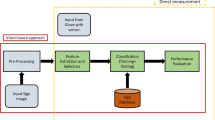Abstract
In recent years, for recognizing sign language, several hardware approaches have been developed using the leap motion controller and Kinect sensors. The sensor-based approaches were costly, and the complexity of designing was high. In machine learning approaches, it was found that less accuracy of prediction occurs as compared to other approaches. As a solution, machine learning-based approaches using image processing evolved as an approach with better prediction and accuracy. In this paper, deep learning approach for sign language recognition (SLR) system has been proposed using AlexNet model. AlexNet is pretrained model, and it is being tested on Indian Sign Language (ISL) Dataset pf Stanford University comprising of alphabets (A–Z) and numerals (0–9). The proposed model has yielded an accuracy of 99.6%.
Access this chapter
Tax calculation will be finalised at checkout
Purchases are for personal use only
Similar content being viewed by others
References
Alnahhas, A., Alkhatib, B., Boukaee, N.A., Alhakim, N., Alz, O.: Recognition of Arabic sign language by using deep learning and leap motion controller. Int. J. Sci. Technol. Res. 8600–8616 (2020)
Baocai, Y., Wentong, W., Lichun, W.: A review of deep learning research. J. Bei**g Univ. Technol. 1, 48–59 (2015)
Zhang, J., Zhu, W., Li, B., Hu, W., Yang, J.: Image copy detection based on convolutional neural networks. In: Chinese Conference on Pattern Recognition, pp. 111–121. Springer, Singapore (2016)
Jebali, M., Dalle, P., Jemni, M.: Extension of hidden Markov model for recognizing large vocabulary of sign language. Int. J. Artif. Intell. Appl. (IJAIA) 665–669 (2012)
Shaojuan, L., Wang, L., Jia, L., Yuan, Y.: Image classification algorithm based on improved AlexNet. J. Phys. Conf. Ser. 1813, 525–529 (2021)
Sharma, S., Singh, S.: Vision based hand gesture recognition using deep learning the interpretation of sign language. Exp. Syst. Appl. J. 4170–4174 (2021)
Zhou, J., Ni, J., Rao, Y.: Block-based convolutional neural network for image forgery detection. In: International Workshop on Digital Watermarking, pp. 65–76. Springer, Cham (2017)
Siddharth, S., Anupam, A.: Vision based hand gesture recognition for human computer interaction. Artif. Intell. Rev. 1–54 (2016)
Pavlovic, V., Sharma, R., Huang, T.S.: Visual interpretation of hand gestures for human computer interaction. IEEE Trans. Pattern Anal. Mach. Intell. 677–695 (1997)
Azrina, S.A., Fammy, A.F.: Evaluation of basic convolutional neural network, AlexNet and bag of features of recognition for indoor objects recognition. Int. J. Mach. Learn. Comput. 9, 123–127 (2019)
Khan, M.A., Kadry, S., Parwekar, P.: Human gait analysis for osteoarthritis prediction, a framework of deep learning and kernel extreme learning machine. Complex Intell. Syst. (2021)
Author information
Authors and Affiliations
Corresponding author
Editor information
Editors and Affiliations
Rights and permissions
Copyright information
© 2023 The Author(s), under exclusive license to Springer Nature Singapore Pte Ltd.
About this paper
Cite this paper
Singh, S., Bhateja, V., Srivastav, S., Pratiksha, Lin, J.CW., Travieso-Gonzalez, C.M. (2023). AlexNet Model for Sign Language Recognition. In: Bhateja, V., Yang, XS., Chun-Wei Lin, J., Das, R. (eds) Intelligent Data Engineering and Analytics. FICTA 2022. Smart Innovation, Systems and Technologies, vol 327. Springer, Singapore. https://doi.org/10.1007/978-981-19-7524-0_46
Download citation
DOI: https://doi.org/10.1007/978-981-19-7524-0_46
Published:
Publisher Name: Springer, Singapore
Print ISBN: 978-981-19-7523-3
Online ISBN: 978-981-19-7524-0
eBook Packages: Intelligent Technologies and RoboticsIntelligent Technologies and Robotics (R0)




